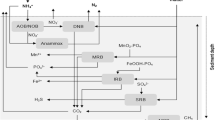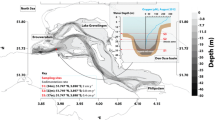Abstract
Bacteria can play an important role in the process of anaerobic phosphorus release: they can act as a direct source of orthophosphates, or as a catalyst of iron hydroxyde reduction. We studied their influence on phosphorus release from highly organic sediments of a Canadian shield lake. Phosphorus and iron release were measured under aerobic and anaerobic conditions, with or without sterilization, and at different pH. We measured also the abundance and activity of bacteria in sediments. The increased P release after sterilization can be explained by cell lysis. Compared to sterilization, changing oxygen concentrations or acidification had little or no effect on P release. In these sediments, phosphorus and iron movements were independent. Most of the total dissolved iron seemed to be linked to humic acids, but not phosphorus.
Résumé
Les bactéries peuvent jouer un rôle considérable dans le relargage anaérobiques du phosphore, soit en catalysant la réduction des hydroxydes de fer, soit comme source directe d'orthophosphates. On a étudié leur importance dans la libération de phosphore à partir des sédiments d'un lac du bouclier canadien, très riches en matière organique. Le relargage de phosphore et de fer a été mesuré en condition aérobique et anaérobique, avec ou sans stérilisation, et à différents pH. On a également mesuré l'évolution du nombre et de l'activité des bactéries dans les sédiments. Le relargage de P après stérilisation peut être expliqué par la lyse cellulaire. Comparativement à la stérilisation, les changements dans la concentration en oxygène ou l'acidification ont peu ou pas d'effet sur le relargage du P. Les mouvements du fer et du phosphore se produisent indépendament à partir de ces sédiments. La plus grande partie du fer total dissous semble lié aux acides humiques, ce qui n'est pas le cas du phosphore.
Similar content being viewed by others
References
Andersen, J. M., 1976. An ignition method for determination of total phosphorus in lake sediments. Wat. Res. 10: 329–331.
Andersen, J. M., 1982. Effect of nitrate concentration in lake water on phosphate release from the sediment. Wat. Res. 16: 1119–1126.
APHA, 1985. Standard Methods for the examination of water and wastewater, 16th edition. American Public Health Association, Washington, D.C., 1268 pp.
Boers, P. C. M., 1991. The influence of pH on phosphate release from lake sediments. Wat. Res. 25: 309–311.
Boström, B., 1984. Potential mobility of phosphorus in different types of lake sediment. Int. Revue ges. Hydrobiol. 69: 457–474.
Boström, B., M. Jansson & C. Forsberg, 1982. Phosphorus release from lake sediments. Arch. Hydrobiol. Beih. Ergebn. Limnol. 18: 5–59.
Boström, B., J. M. Andersen, S. Fleischer & M. Jansson, 1988. Exchange of phosphorus across the sediment-water interface. In G. Persson & M. Jansson (eds), Phosphorus in Freshwater Ecosystems. Developments in Hydrobiology 48. Kluwer Academic Publishers, Dordrecht: 229–244. Reprinted from Hydrobiologia 170.
Byers, C., E. L. Mills & P. L. Stewart, 1978. A comparison of methods of determining organic carbon in marine sediments, with suggestions for a standard method. Hydrobiologia 58: 43–47.
Duarte, C. M., D. F. Bird & J. Kalff, 1988. Submerged macrophytes and sediment bacteria in the littoral zone of Lake Memphremagog (Canada). Verh. int. Ver. Limnol. 23: 271–281.
Einsele, W., 1936. über die Beziehungen des Eisenkreislaufs zum Phosphatkreislauf im eutrophen See. Arch. Hydrobiol. 29: 664–686.
Einsele, W., 1938. Über chemische und kolloidchemische Vorgänge in Eisen-Phosphat-Systemen unter limnochemischen und limnogeologischen Gesichtspunkten. Arch. Hydrobiol. 33: 361–387.
Fleischer, S., 1978. Evidence for the anaerobic release of phosphorus from lake sediments as a biological process. Naturwissenschaften 65: 109–110.
Fleischer, S., 1983. Microbial phosphorus release during enhanced glycolysis. Naturwissenschaften 70: 315.
Fleischer, S., 1986. Aerobic uptake of Fe(III)-precipitated phosphorus by microorganisms. Arch. Hydrobiol. 107: 269–277.
Fleischer, S., M. Bengtsson & G. Johansson, 1988. Mechanism of the aerobic Fe(III)-P solubilization at the sediment-water interface. Verh. int. Ver. Limnol. 23: 1825–1829.
Florentz, M., P. Granger & P. Hartemann, 1984. Use of 31P nuclear magnetic resonance spectroscopy and electron microscopy to study phosphorus metabolism of microorganisms from wastewaters. Appl. envir. Microbiol. 47: 519–525.
Foy, R. H., 1986. Suppression of phosphorus release from lake sediments by the addition of nitrate. Wat. Res. 20: 1345–1351.
Francko, D. A. & R. T. Health, 1979. Functionally distinct classes of complex phosphorus compounds in lake water. Limnol. Oceanogr. 24: 463–473.
Fuhs, G. W. & M. Chen, 1975. Microbiological basis of phosphate removal in the activated sludge process for the treatment of wastewater. Microb. Ecol. 2: 119–138.
Gächter, R., J. S. Meyer & A. Mares, 1988. Contribution of bacteria to release and fixation of phosphorus in lake sediments. Limnol. Oceanogr. 33: 1542–1558.
Gächter R. & J. S. Meyer, 1993. The role of microorganisms in mobilization and fixation of phosphorus in sediments. In P. C. M. Boers, T. E. Cappenberg & W. van Raaphorst (eds), Proceedings of the Third International Workshop on Phosphorus in Sediments. Developments in Hydrobiology 84. Kluwer Academic Publishers, Dordrecht: 103–121. Reprinted from Hydrobiologia 253.
Heldal, M., S. Norland & O. Tumyr, 1985. X-ray microanalytic method for measurement of dry matter and elemental content of individual bacteria. Appl. envir. Microbiol. 50: 1251–1257.
Jansson, M., 1987. Anaerobic dissolution of iron-phosphorus complexes in sediment due to the activity of nitrate-reducing bacteria. Microb. Ecol. 14: 81–89.
Jones, J. G., S. Gardener & B. M. Simon, 1983. Bacterial reduction of ferric iron in a stratified eutrophic lake. J. Gen. Microbiol. 129: 131–139.
Lafond, M., B. Pinel-Alloul & P. Ross, 1990. Biomass and photosynthesis of size-fractionated phytoplankton in Canadian Shield lakes. Hydrobiologia 196: 25–38.
Malnou, D., P. Chopard & H. Andrearczyk, 1983. La déphosphatation biologique: peut-on y croire? T.S.M.-L'Eau 78: 63–71.
Mortimer, C. H., 1941. The exchange of dissolved substances between mud and water in lakes. I.J. Ecol. 29: 280–329.
Mortimer, C. H., 1942. The exchange of dissolved substances between mud and water in lakes. J. Ecol. 30: 147–201.
Ohtake, H., K. Takahashi, Y. Tsuzuki & K. Toda, 1984. Phosphorus release from a pure culture of Acinetobactre calcoaceticus under anaerobic conditions. Envir. Tech. Lett. 5: 417–424.
Ostrofsky, M. L., 1987. Phosphorus species in the surficial sediments of lakes of eastern North America. Can. J. Fish. aquat. Sci. 44: 960–966.
Perdue, E. M., K. C. Beck & J. H. Reuter, 1976. Organic complexes of iron and aluminium in natural waters. Nature 260: 418–420.
Porter, K. G. & Y. S. Feig, 1980. The use of DAPI for identifying and counting aquatic microflora. Limnol. Oceanogr. 25: 943–948.
Sakata, M., 1985. Diagenetic remobilisation of manganese, iron, copper and lead in anoxic sediment of a freshwater pond. Wat. Res. 19: 1033–1038.
Schallenberg, M., J. Kalff & J. B. Rasmussen, 1989. Solutions to problems in enumerating sediment bacteria by direct counts. Appl. envir. Microbiol. 55: 1214–1219.
Schwartzbrod, J. & G. Martin, 1985. Les micro-organismes, agents biogéochimiques. p. 1–45. In Point sur l'épuration et le traitement des effluents. 2.1 Bactériologie des milieux aquatiques. G. Martin (ed.), Technique et Documentation Lavoisier, Paris.
Shapiro, J., 1967. Induced release and uptake of phosphate by microorganisms. Science 155: 1269–1271.
Sinke, A. & T. E. Cappenberg, 1988. Influence of bacterial processes on the phosphorus release from sediments in the eutrophic Loosdrecht Lakes, The Netherlands. Arch. Hydrobiol. Beih. Ergebn. Limnol. 30: 5–13.
Sørensen, J., 1982. Reduction of ferric iron in anaerobic, marine sediment and interaction with reduction of nitrate and sulfate. Appl. envir. Microbiol. 43: 319–324.
Stewart, A. J. & R. G. Wetzel, 1981. Dissolved humic materials: photodegradation, sediment effects, and reactivity with phosphate and calcium carbonate precipitation. Arch. Hydrobiol. 92: 265–286.
Stolp, H. & M. P. Starr, 1965. Bacteriolysis. Ann. Rev. Microbiol. 19: 79–104.
Stumm, W. & J. J. Morgan, 1981. Aquatic Chemistry. An introduction emphasizing chemical equilibria in natural water. 2nd edition. John Wiley & Sons, Toronto. 780 pp.
Tipping, E., 1981. Adsorption by goethite (α-FeOOH) of humic substances from three different lakes. Chem. Geol. 33: 81–89.
Trevors, J. T., 1984. The measurement of electron transport system (ETS) activity in freshwater sediment. Wat. Res. 18: 581–584.
Author information
Authors and Affiliations
Additional information
A contribution to the GRIL (Groupe de Recherche Interuniversitaire de Limnologie)
Rights and permissions
About this article
Cite this article
de Montigny, C., Prairie, Y.T. The relative importance of biological and chemical processes in the release of phosphorus from a highly organic sediment. Hydrobiologia 253, 141–150 (1993). https://doi.org/10.1007/BF00050734
Issue Date:
DOI: https://doi.org/10.1007/BF00050734




